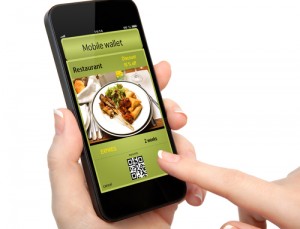QR codes for quick pay
 QR (Quick Response) codes are being increasingly pushed as quick and easy payment solutions.
QR (Quick Response) codes are being increasingly pushed as quick and easy payment solutions.
Businesses are able to create multiple codes and add them to bills as well as business cards, websites, point or sale and product labelling. Customers then scan the QR code using apps that have been downloaded onto their mobile devices, which link to an online payment page set up for the payment in question. Payment is then instant for both parties.
Banks such as Barclays are promoting their own handy QR payment service along with payment and mobile app companies like Pay Pal and Zapper.
Zapper is particularly pushing for UK restaurants to allow diners to pay for their meals using its app. Free to download by customers, the app allows restaurants to add a payment QR code to customers’ receipts, both paper and digital. After receiving their bill, the diner then simply scans the QR code and pays for the bill via the app with no need for additional service. It even supports splitting the bill.
To use the service, the customer just needs to set up a payment profile. The app also can also send a digital receipt to the diner by email and handles the transaction between them and the restaurant. Bradley Duke, managing director for Europe at Zapper said about the app, “We wanted to create a system that was of great benefit to customers and businesses of all sizes, leveraging the powerful technology that we all already carry around in our pockets. With Zapper sole-traders and SME’s don’t have to worry about handling checks or customers having cash on them. As long as customers have their smartphones with them, they can make payments anytime and anywhere they like with the same guarantee of safety and security that they have with a normal credit card payment…just without the hassle. It’s an easier way to pay and a result, they are more likely to pay rather than leave it and pay late. It also gives people the choice of using credit cards when cash may be tight.”
The concept behind the QR payment code sounds like it should carry a great success story, yet despite the wealth of technology behind it consumers are slow to adopt the tool. Apparently the apps aren’t ‘hack’ proof so security levels may be partly to blame for this.
In fact Reuters reports that China’s central bank has recently demanded that payments made by scanning a code with mobile devices be halted, following concerns about the security of verification procedures. Mobile transactions are growing particularly fast in China with its three Internet giants investing heavily in technologies and businesses that make use of scanning QR codes with mobile devices to cash in on China’s 500 million smartphone and tablet users. According to Beijing-based data firm iResearch QR codes, which can be scanned with mobile devices to transmit payment details, are expected to be a driving force in the mobile payment market this year.
For those consumers using mobile payment technology, digital is actually becoming the norm. According to Nielsen’s Q2 2014 Mobile Wallet Report, 40% of mobile wallet users say they use mobile methods as their primary mode of payment. The insights showed that 29% of smartphone payers pay for goods at a store by scanning a bar code or QR code (when present) using the device’s camera. Plus, 45% will also pay for the goods by presenting the merchant with a barcode or QR code for the service staff to scan.
So, why are QR codes so popular among the adopters of mobile payment?
The main customer benefits of using QR codes for payment include:
- Cash-less, card-less and paper-less solution, reducing the need to carry a wallet around at all times hold onto physical receipts.
- Faster way to pay, saving time by enabling the customer to handle the transaction at their pace rather than waiting on the service staff.
- Convenient option for on the spot payment and instant redemption of offers.
Meanwhile key benefits to businesses include:
- Members of staff have more time to focus on additional service tasks.
- Customer turn around is faster allowing more customer footfall in a day.
- The app registration is a very useful tool for data collection, which can be used for additional activities like email and mobile marketing.
- Easy way to take advantage of mobile payment popularity without a big technology investment.
- QR codes can be used outside of payment such as for marketing purposes by adding them to menus, websites, posters, receipts, vouchers, etc.


No comments yet.